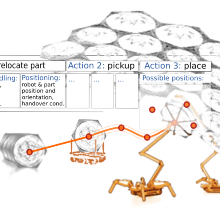Cluster of Excellence Integrative Computational Design and Construction for Architecture (IntCDC)
The vision of the Cluster of Excellence IntCDC at the University of Stuttgart and the Max Planck Institute for Intelligent Systems is to harness the full potential of digital technologies to rethink design and construction while laying the methodological foundations to profoundly modernize the design and construction process and related building systems. One key objective is to develop an overarching methodology of co-designing methods, processes and systems based on interdisciplinary research encompassing architecture, structural engineering, building physics, engineering geodesy, manufacturing and systems engineering, computer science and robotics, humanities and social sciences. In this way, the cluster aims to address the ecological, economic and social challenges and to provide the prerequisites for a high-quality and sustainable built environment and a digital building culture.
Research Project 17
Building construction typically relies on a centralized design, in which information is used to produce the most appropriate sequence of assembly actions which are assumed to serve as the unambiguous blueprint for building execution. However, uncertainties in actions which lead to violations of tolerances, true dimensions of fabricated modules as well as changes in the environment can require frequent replanning, the cost of which may be prohibitive for construction projects which have reached a level of complexity that becomes increasingly difficult to plan. For similar reasons on-site assembly is often prawn to purely reactive and manual operating sequences. The central goal of this research project is to master the increasing level of complexity for on-site construction of high-performance building systems by decentralized planning strategies which compute smart assembly sequences based on AI reasoning and thus enable new processes in the research area of on-site large-scale robotic construction.
Research Aspects
- Coarse assembly planning using Logic-Geometric Programming
- Modeling abstractions of building systems in interaction with construction robotics for the analyses of structural states and constructive integrity
- Modellpredictive control strategies for robotic construction


